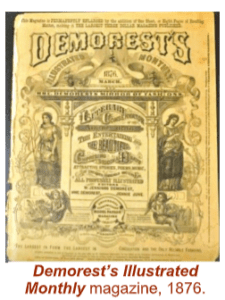 The Rewrite: Glorianna Fulsom vs Abby Folsom
The Rewrite: Glorianna Fulsom vs Abby Folsom
Stratford Historical Society
By David Wright
Historian
Since February is considered the most “romantic” month of the year, we thought enjoy reading some background on Stratford’s most romantic tale, the Glorianna Fulsom story. This uniquely Stratford story is truly a “Cinderella” tale. We’ve learned that there are about 345 variants of the Cinderella story which was first printed in Italy in 1634. There are some very strange versions of the story including one where Cinderella’s step sisters plot with Cinderella to murder, then eat their mother.
You may even enjoy reading up on some of the unusual variants of the Cinderella story at https://www.npr.org/2015/03/13/392358854/a-girl-a-shoe-a-prince-the-endlessly-evolving -cinderella. Stratford’s version of the Cinderella story is nowhere near as gruesome, or odd, as some of the 345 variants, but shares with the Cinderella story many different versions and retellings.
We recently discovered a 1902 newspaper article from The Thompsonville Press (Thompsonville, CT) relating the story of the Phelps Mansion. In that same article was another story about one “Abbie Folsome”. The story was a very unique and original re-telling of the Glorianna Fulsom story which was first documented in Stratford history in print by Rev. Samuel Orcutt in his s1886 “A History of the Old Town of Stratford Volume 1”.
In The Thompsonville Press article, not only was Glorianna Fulsom’s name rendered as Abbie Folsom. Not only was Glorianna’s name changed, but so were the names of other townspeople. The timing of the story was a few years earlier than the Orcutt story, and, the story was morphed into a tale more of heroic Revolutionary deeds by Stratford citizens than the romance tale we are accustomed to thinking of when we think of Glorianna Fulsom. A quick search of the internet for the names Abbie Folsom and Abby Folsom yielded a rich harvest of 1879-1880 newspaper articles which relating, almost verbatim, The Thompsonville Press article published in 1902. In Orcutt’s 1882 telling of Glorianna’s romance, he even related that there was a spurious Revolutionary War story pertaining to the Glorianna Folsom romance. Orcutt must have been aware of these 1880 newspaper articles. Orcutt derived his tale from two of Glorianna’s nieces who had heard the original tale from their mother, Glorianna’s older sister, many, many years earlier.
It caused us to wonder how the earlier stories had come to exchange Glorianna Fulsom’s name with Abbie Fulsom.
A bit more searching yielded a story printed in the Demorest’s Monthly Illustrated Magazine from 1876. The story was an earlier re-telling of the Glorianna Fulsom romance as written by Lillie Devereux Blake. In Lillie’s story, Glorianna Fulsom was identified as Abby Folsom and the setting of the story was at the conclusion of the Revolutionary War which would have been some time after 1783.
You may recall from other 2020 Stratford events the proposed destruction of the Lillie Devereux Blake home on Main Street. Lillie Devereux Blake was one of the most prominent leaders of the Suffrage movement of the early 1900s. She was an accomplished author, and had begun her writing career at her mother’s home on Main Street in Stratford in 1860.
Additionally, Lillie was Samuel William Johnson’s grand-daughter. Samuel Johnson’s house is, and was, located on the corner of West Broad Street and Main Street. Prior to the construction of the Johnson home on this corner, the property belonged to John Folsom (Fulsom). John was a well-known and respected blacksmith. The Johnson home was built in in 1799. Lillie was born in 1833 and spent much of her young life at her grandfather’s home. During one of her visits to her grandfather’s home, Lillie’s grandfather related the story she told in 1876. In this story, Glorianna’s name is first mentioned in print as “Abby”. We’re quite certain all later retellings of the Glorianna Fulsom story based her name on Lillie’s 1876 story. However, Lillie’s story was silent on the Revolutionary War heroism mentioned in virtually all the 1880-1915 newspaper articles.
Lillie’s 1876 story filled in many details that were not included in Orcutt’s telling of the story. Details that made the Glorianna story make much more sense. So who got the story right: Orcutt or Lillie Blake? Both stories were based on second-hand information related by elderly people whose memories may not have been totally clear as to all the details. We suspect that some combination of Orcutt’s Glorianna Fulsom story, and Lillie Blake’s Abby Folsom story, is the “whole” story.
We’ve included on the home page of our newsletter website (www.stratfordhistoricalsociety .info), Orcutt’s and Devereux- Blake’s version of the Glorianna story as well as several of the other version published between 1865 and 1915. The Hartford Courant actually printed three different versions of this story, over the years, including one version which situated the romance in Stratford, Ontario, Canada.
The Bossier Banner August 31, 1876
LORD STIRLING’S COURTSHIP.
BY Lillie Devereux Blake
My grandfather, and my great-grand-father, and my great-great-grandfather, all lived in Stratford, Connecticut. The old homestead stood on the main street off the village, opposite the church, which the first one of the race, the Rev. Samuel Johnson, had helped to build. There were great elms shading the walk before the gate, and in the deep yard mulberry and horse-chestnut trees. Around the stone “stoop” flourished lilac and arcanthus bushes, and there were clumps of mighty box beside the walk.
Back of the house, on a side street, were the stables and farms, and on the other side stretched a deep garden, with a row of willow trees shading it at the lower end. One day, when I was a child, I was playing with some- companions near these willows, when we saw a queer-looking bit of iron protruding from the ground, and digging about it, presently unearthed a horse-shoe, with which we went, full of eager questioning, to my grandfather, Judge Johnson.
“How did it get there, grandpa?” we all queried in chorus. “There once stood, just where you found this, little ones, a blacksmith shop, and I dare say if you were to search that you would find many queer bits of iron in the ground.” “And where is the blacksmith now, grandpa?” I asked. “He is dead, my dear, but his only daughter was one or the great ladies of England; when you are older you shall hear the story.”
We ran away to our play, and for days afterward amused ourselves by digging for iron on the site of the former blacksmith’s shop. We were rewarded by-finding many odd broken bits, and long afterwards, when I was old enough to understand the story, I was told the romance of Lord Stirling’s courtship.
Rather than a century ago, after the close of the Revolutionary war, when prosperity had dawned on the yoting Republic, there came to this quiet village a handsome
In 1870, on the one hundredth anniversary of the Gloriana Folsom marriage to a Scottish Baron, many papers throughout America ran the following story.
Alexandria (VA) Gazette
September 5, 1870 A Romantic Story. From the Nation.
At the commencement of the present century a young man made his appearance in Stratford, and spent a few weeks at the tavern, which then existed to afford shelter to stage-coach travelers [sic]. Whence he came and what his business none could guess.
Directly opposite the tavern stood the small cottage and forge of a blacksmith named Folsom. He had a daughter, who was the beauty of the village, and it was her fortune to captivate the heart of the young stranger. He told, his love; he was from Scotland; that he was travelling incognito., but in confidence gave her his real name, claiming that he was heir to a large fortune. She returned his love, and they were married.
A few weeks thereafter the stranger told his wife that he must visit New Orleans. He did so, and the gossips of the town made the young wife unhappy by disagreeable hints and jeers. In a few months the husband returned, but before a week had elapsed he received a large budget of letters, and told his wife that he must at once return to England, and must go alone. He took his departure, and the gossips had another glorious opportunity to make a confiding woman wretched. To all but herself it was a clear case of desertion.
The wife became a mother, and for two years lived on in silence and hope. At the end of that time a letter was received by the Stratford beauty from her husband directing her to go at once to New York with her child, taking nothing with her but the clothes she wore, and embark in a ship for her home in England.
On her arrival in “New York she found a ship splendidly furnished with every convenience and luxury for her comfort, and two servants ready to obey every wish that she might express. The ship duly arrived in England, and the Stratford girl became the mistress of a superb mansion, and, as the wife of a baronet, was saluted by the aristocracy as Lady Samuel Stirling.
On the death of her husband, many years ago, the Stratford boy succeeded to the title and wealth of his father, and in the last edition of the Peerage and Baronetage he is spoken of as the issue of “Miss Folsom, of Stratford, North America.” When the late Professor Silliman visited England, some years since, he had the pleasure of meeting Lady Stirling at a dinner party, and was delighted to answer her many questions about her birthplace in Connecticut. When Glorianna Folsom was born on 24 December 1753, in Stratford, Fairfield, Connecticut Colony, British Colonial America, her father, Samuel Folsom, was 37 and her mother, Anne Bingham, was 37. She married Sir John Baronet Sterling on 28 January 1774. They were the parents of at least 10 sons and 8 daughters. She died on 4 January 1826, at the age of 72.


What a great story. Stratford has some amazing history. Thank you David for sharing you knowledge.